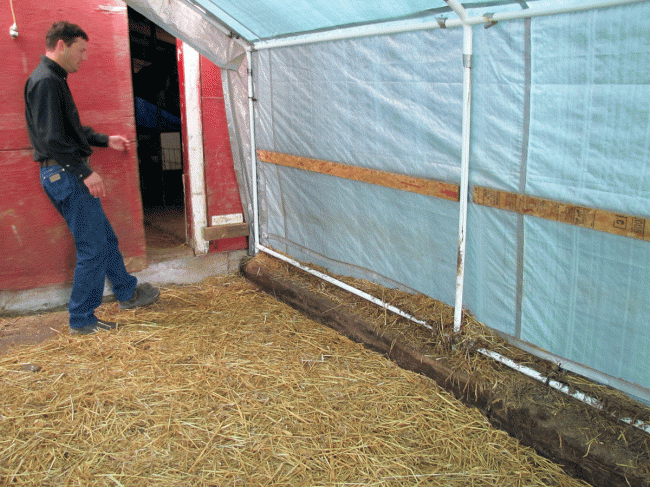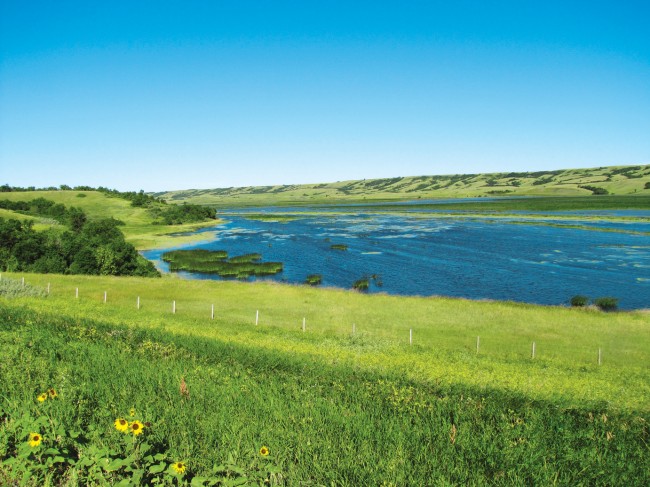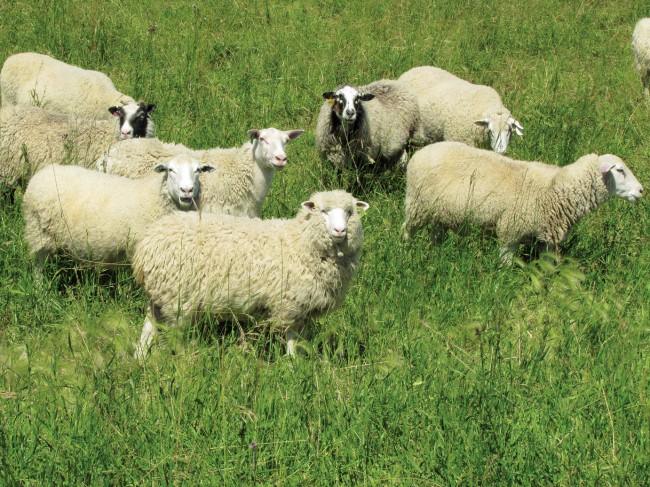Story & photos by Cathy Gallivan, PhD
July 21st was a gloriously sunny day as I drove 30 minutes north of Regina to visit Trent and Sandy Larson at their sheep operation along the beautiful Qu’Appelle River valley. It was a busy day for the Larsons, who kindly made time to talk to me smack in the middle of haying season and with a new barn going up in the yard.
Trent and Sandy started raising sheep on an acreage near Stony Plain, Alberta, in 2002, when Trent was working as a police officer with the City of Edmonton. In 2006, they decided to expand their operation, and came to Saskatchewan in search of more affordable land. A retiring grain farmer sold them 620 acres, they put up some fences and small shelters and moved their flock of 80 ewes from Alberta. The flock now stands at 370 head, including ewe lambs, and is entirely descended from the original Alberta ewes.
The Larsons started with Romanovs for high prolificacy and out-of-season breeding ability, then added Dorset genetics to improve the lamb carcass while retaining the aseasonality. They are now using Rideau Arcott rams to sire replacement ewe lambs in an effort to add more milk; the first of the Rideau Arcott crosses are lambing this year. Texel and Canadian Arcott rams are used as terminal sires.
Trent and Sandy lamb three times per year – in December/January, April/May and August/September. The entire ewe flock goes out to pasture in the summer time, but lambs are weaned, kept in the yard and fed a pelleted ration plus free-choice hay. Trent makes his own hay, but purchases all the concentrates the flock requires.
Trent sees lots of opportunity for expansion in the industry. He says the demand is there for a Canadian product, and the industry needs to take advantage of it. But with many Canadian sheep farmers being close to retirement age, and many others limited to hobby operations, the Canadian industry needs young farmers to run larger flocks and/or lamb more often than once per year.

The old lambing barn was extended by the use of three fabric garages, joined end to end.
The Larsons are definitely in expansion mode. The new barn (40’ x 100’) will serve as the lambing barn, freeing up the older hip-roofed barn for the lambs reared on milk replacer and the rams. More corrals will be built to tie the new barn in with the rest of the existing facilities. They are also making the switch from hand-feeding to self-feeding lambs in the feedlot. The goal is to have 600 ewes, producing a 200% lamb crop every eight months, for a total of 1,800 lambs sold per year. From there, they might expand to 1,000 ewes, if they can acquire the land to support a flock of that size.

The ‘tunnel’ addition provided space for ewes to drop lambs before being moved into the old barn.
A key to meeting this goal is having the ewes conceive for the lambings they are scheduled for. Trent and Sandy have learned that the rams do a better job of breeding the ewes during the hot days of summer when they are confined to about five acres, rather than running on 80 acres.
Ewes are exposed for fall lambing without any assistance from artificial hormones or light control, and the results are good: 80% of ewes exposed in the spring go on to lamb in the fall. Ewe lambs are selected from all three lambings, and exposed to lamb at one year of age. Ewe lambs born in the fall, however, usually end up lambing for the first time in the winter at 16 months of age.
Ewes are sheared prior to each lambing. Lambing rates are highest in the spring lambing, when the flock drops around 225% with 200% marketed. With a high percentage of ewe lambs in the flock, the average is closer to 200% dropped and 190% marketed. Ewes routinely raise three lambs, depending on the season and their condition, but about 80 lambs a year are raised on milk replacer.

The tunnel was surprisingly bright inside.
Trent finds that the Rideau Arcotts and Dorsets adapt well to confinement. They thrive on the pasture in the summer (in the company of a guard dog), but choose to come in to the yard in the evenings as it gets dark.
An effective handling system located inside an old grain bin allows for rapid processing of sheep and lambs in any weather. Ewes are vaccinated for clostridial diseases every year in the fall, and lambs at one month of age. Ewes are wormed prior to lambing in the spring and fall, but not before the winter lambing.
Most of the lambs are marketed as feeders at around 90 lb., which keeps them moving through the facilities in time for the next group of lambs to be born and fed.
Trent and Sandy are strong proponents of the advantages of traceability equipment. Lambs are RFID-tagged and numbers are read automatically with a Psion tag reader as the lamb steps in the scale. The scale is electronic but not connected to the Psion, so Sandy reads the lamb’s weight from the scale head, then types it into the Psion where it is stored with the tag number for later downloading into the computer. Using this system, the Larsons can move a group of 440 lambs through the system and weigh them in about three hours.
In addition to farming, Trent does construction/renovation work in the community. He and Sandy have three children (Jocelyn, Nolan and Megan) who keep them very busy as well.

This round bale feeder was constructed from galvanized wire panels. The lambs are able to push it around and eat the whole bale, but they do lose an ear tag occasionally.
Trent also makes time to be actively involved in the industry, serving as a director on the Saskatchewan Sheep Development Board, and also as Saskatchewan’s representative to the Canadian Sheep Federation (CSF). Trent says the CSF’s greatest value is the knowledge and advancements that can be gained through communication and cooperation with farmers across the country.
There is no doubt that Trent and Sandy are ready to do what they can to help the Canadian industry meet its objective of expansion; having spent a short time with them, I left feeling more optimistic about the future.








